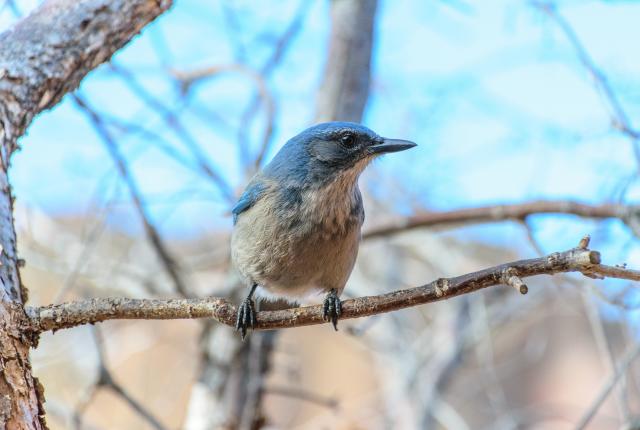PINYON JAYS LIKE TO ANNOUNCE THEMSELVES with a chuckling kind of call, sung out while they fly overhead or settle into chatty flocks, often perched in the branches of the pine tree with which they share a name. In the Southwest, the medium-size, dusky-blue bird with a sharp bill has long been a familiar face. Dozens commonly filled the sky at a time.
But volunteers in the North American Breeding Bird Survey program have documented pinyon jay numbers in persistent and worrying decline over the last 50 years. Those once massive flocks have become rare sightings. Yet a research team that systematically surveys the Gila National Forest has suggested it may be a hot spot, where this imperiled bird has found something particularly important to their abilities to thrive.
“The Gila National Forest is a treasure, not just for pinyon jays but for many other wildlife species,” says Kristine Johnson, a retired member of the biology department at the University of New Mexico who led the team that conducted what is likely the first systematic survey of pinyon jays in the area. “It’s just big and wild, and much of it is not highly disturbed.”
Throughout a range that spans from New Mexico to Idaho, the pinyon jay population has dropped by an estimated 85 percent since 1970. The U.S. Fish and Wildlife Service recently agreed to consider it for threatened or endangered species status. While the causes of the decline are unclear, researchers suspect climate change and its effects on piñon pines, whose nuts are a primary food source.
“There’s been concern for quite a while, just because of the huge decrease in populations range-wide,” says Jerry Monzingo, a biologist with the Gila National Forest.
Johnson’s interest in the Gila was sparked by the annual Breeding Bird Survey, which reported stable or even increasing populations of pinyon jays in the Gila National Forest. For her research, surveyors drove to points spaced 1 kilometer apart along roads. (“It’s a huge area,” Johnson says of the 3.3-million-acre forest, which includes the Gila Wilderness. “To do this on foot, you’d have to have millions of dollars and an army of people.”) Then they waited for six minutes and recorded whether pinyon jays appeared and what they were doing.
Johnson and her team reported an abundant number of these jays, particularly in the northern end of the national forest. Over the three-year effort, they found 21 nesting colonies, 12 of which were active last spring—a big deal for a bird that will choose not to reproduce when food supplies are running thin. They also observed pinyon jays nesting in ponderosa pines, though piñon trees are more typical for nest sites.
“That’s encouraging in terms of the Forest Service management goals,” says Johnson. Thinning work, where forest managers cut down some trees to reduce the risk of an extreme wildfire, typically is hard on jays. But in the Gila, the birds seem to be using areas even after those changes to the canopy and composition.
Johnson has also noticed birds staying with their bigger winter flocks later in the spring, rather than dispersing to nest. This behavior could indicate that if piñon pines are producing fewer nuts due to ongoing drought, the birds are waiting to reproduce until spring, when insects are more plentiful to feed their fledglings.
Where and when to go see pinyon jays are tricky questions to answer. Researchers are careful to obscure nesting locations because even well-meaning birders can disturb nesting birds or attract ravens, which feed on fledglings. Plus, the pinyon jay is known to frequently travel its vast habitat, Johnson says. “You could go all over the northern Gila and never see them, or you might see flocks of them.”
Read more: Home to hundreds of species, the Gila Wilderness is a bird-watcher’s paradise.



